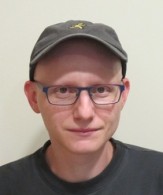Previous page
 Vadim AXELROD
Post Doc
Team “Physiological investigation of clinically normal and impaired cognition”
Vadim AXELROD
Post Doc
Team “Physiological investigation of clinically normal and impaired cognition”
 Vadim AXELROD
Post Doc
Team “Physiological investigation of clinically normal and impaired cognition”
Vadim AXELROD
Post Doc
Team “Physiological investigation of clinically normal and impaired cognition”
Biography
I am a postdoctoral fellow working with Prof. Lionel Naccache (Institut du Cerveau et de la Moelle épinière, Paris). Previously, I completed three-year postdoc under joint supervision of Prof. Geraint Rees (Institute of Cognitive Neuroscience, University College London) and Prof. Moshe Bar (Bar-Ilan University). I have obtained my PhD in Tel-Aviv University (School of Psychological Sciences, Prof. Galit Yovel).Current projects:
- Understanding various aspects of human cognition using intracranial depth recording in patients suffering from epilepsy (local field potentials and single units)
- Investigation of neural mechanisms of brain-damaged patients (e.g., patients in vegetative state) using cutting-edge fMRI resting state connectivity methods
- Exploration of neural network dynamics and spontaneous activity during different conscious states (e.g., awake, sleep, different task-based activity)
Main research skills and methods:
- Functional MRI (fMRI)
- Magnetoencephalography (MEG)
- Transcranial direct current stimulation (tDCS)
- Intracranial depth electrodes and single units in humans
Publications:
1. Axelrod V (2016) On the domain-specificity of the visual and non-visual face-selective regions. Eur J Neurosci 44:2049-2063.
2. Axelrod, V., Rees, G., Lavidor, M., & Bar, M. (2015). Increasing propensity to mind wander with transcranial direct current stimulation. Proceedings of the National Academy of Sciences, 112(11), 3314-3319
• Highlighted: Broadway et al., (2015), PNAS, 112(11), 3182-3183.
• Commented: Fox, K. C. R., & Christoff, K. (2015), PNAS, 112(19).
3. Axelrod, V., Bar, M., Rees, G., & Yovel, G. (2015). Neural correlates of subliminal language processing. Cerebral Cortex, 25(8), 2160-2169
4. Axelrod V, Bar M, Rees G (2015) Exploring the unconscious using faces. Trends in Cognitive Sciences 19:35-45
5. Axelrod, V., & Yovel, G. (2015). Successful decoding of famous faces in the Fusiform Face Area. Plos One, 10(2), e0117126
6. Axelrod, V., & Teodorescu, A. R. (2015). Commentary: When the brain takes a break: a model-based analysis of mind wandering. Frontiers in computational neuroscience, 9(83)
7. Axelrod V, (2014) Minimizing bugs in cognitive neuroscience programming, Frontiers in Psychology, 5
8. Axelrod V, Rees G (2014) Conscious awareness is required for holistic face processing. Consciousness and Cognition 27:233-245
9. Axelrod, V., & Yovel, G. (2013). The challenge of localizing the anterior temporal face area: A possible solution. Neuroimage, 81(0), 371-380
• Faculty of 1000 (F1000) paper selection
10. Axelrod, V., & Yovel, G. (2012). Hierarchical Processing of Face Viewpoint in Human Visual Cortex. Journal of Neuroscience, 32(7), 2442-2452
• Faculty of 1000 (F1000) paper selection
11. Axelrod, V., & Yovel, G. (2011). Nonpreferred Stimuli Modify the Representation of Faces in the Fusiform Face Area. Journal of Cognitive Neuroscience, 23(3), 746-756
12. Axelrod, V., & Yovel, G. (2010). External facial features modify the representation of internal facial features in the fusiform face area. Neuroimage, 52(2), 720-725
13. Axelrod, V. (2010). The Fusiform Face Area: In Quest of Holistic Face Processing. Journal of Neuroscience, 30(26), 8699-8701


